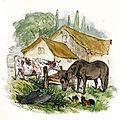Animal husbandry
Animal husbandry is the branch of agriculture concerned with animals that are raised for meat, fibre, milk, eggs, or other products. It includes day-to-day care, selective breeding and the raising of livestock.
History[edit]
Animal husbandry has been practiced for thousands of years, since the first domestication of animals. The science of animal husbandry is called zootechnics, which is part of the larger field of agriculture.
Types of Animals[edit]
There are several types of animals that are commonly raised in animal husbandry. These include cattle, sheep, goats, poultry, swine, and horses. Each of these animals requires different care and is used for different products.
Breeding[edit]
Breeding in animal husbandry is an important aspect, as it allows for the improvement of livestock. This can be done through selective breeding, where animals with desirable traits are bred together to produce offspring with those traits. This can include traits such as size, growth rate, resistance to disease, and quality of meat or milk.
Animal Welfare[edit]
Animal welfare is a key concern in animal husbandry. This includes ensuring that animals are kept in good health, are not subjected to unnecessary suffering, and are provided with a suitable environment to live in. This can involve providing adequate food and water, appropriate shelter, and veterinary care.
Environmental Impact[edit]
Animal husbandry has a significant environmental impact. This includes the production of greenhouse gases, deforestation for pasture, and pollution from animal waste. There are efforts to reduce this impact through sustainable farming practices.
See Also[edit]

This article is a agriculture stub. You can help WikiMD by expanding it!
Animal husbandry[edit]
-
Cattle Feedlot near Rocky Ford, CO
-
Fat tailed sheep, Afghanistan, 1976
-
Egyptian Domesticated Animals
-
Sheep in pen medieval France 15th century MS Douce 195
-
o aye
-
Herdwicks Lake District
-
Hog confinement barn interior
-
Cattle round a feeder with Avon Farm
-
LeinPresskuchen-CBIO
-
Vaccination of goat in Niger
-
Farmyard Drawing
-
Merino shearing
Ad. Transform your life with W8MD's Budget GLP-1 injections from $75


W8MD offers a medical weight loss program to lose weight in Philadelphia. Our physician-supervised medical weight loss provides:
- Weight loss injections in NYC (generic and brand names):
- Zepbound / Mounjaro, Wegovy / Ozempic, Saxenda
- Most insurances accepted or discounted self-pay rates. We will obtain insurance prior authorizations if needed.
- Generic GLP1 weight loss injections from $75 for the starting dose.
- Also offer prescription weight loss medications including Phentermine, Qsymia, Diethylpropion, Contrave etc.
NYC weight loss doctor appointmentsNYC weight loss doctor appointments
Start your NYC weight loss journey today at our NYC medical weight loss and Philadelphia medical weight loss clinics.
- Call 718-946-5500 to lose weight in NYC or for medical weight loss in Philadelphia 215-676-2334.
- Tags:NYC medical weight loss, Philadelphia lose weight Zepbound NYC, Budget GLP1 weight loss injections, Wegovy Philadelphia, Wegovy NYC, Philadelphia medical weight loss, Brookly weight loss and Wegovy NYC
|
WikiMD's Wellness Encyclopedia |
| Let Food Be Thy Medicine Medicine Thy Food - Hippocrates |
Medical Disclaimer: WikiMD is not a substitute for professional medical advice. The information on WikiMD is provided as an information resource only, may be incorrect, outdated or misleading, and is not to be used or relied on for any diagnostic or treatment purposes. Please consult your health care provider before making any healthcare decisions or for guidance about a specific medical condition. WikiMD expressly disclaims responsibility, and shall have no liability, for any damages, loss, injury, or liability whatsoever suffered as a result of your reliance on the information contained in this site. By visiting this site you agree to the foregoing terms and conditions, which may from time to time be changed or supplemented by WikiMD. If you do not agree to the foregoing terms and conditions, you should not enter or use this site. See full disclaimer.
Credits:Most images are courtesy of Wikimedia commons, and templates, categories Wikipedia, licensed under CC BY SA or similar.
Translate this page: - East Asian
中文,
日本,
한국어,
South Asian
हिन्दी,
தமிழ்,
తెలుగు,
Urdu,
ಕನ್ನಡ,
Southeast Asian
Indonesian,
Vietnamese,
Thai,
မြန်မာဘာသာ,
বাংলা
European
español,
Deutsch,
français,
Greek,
português do Brasil,
polski,
română,
русский,
Nederlands,
norsk,
svenska,
suomi,
Italian
Middle Eastern & African
عربى,
Turkish,
Persian,
Hebrew,
Afrikaans,
isiZulu,
Kiswahili,
Other
Bulgarian,
Hungarian,
Czech,
Swedish,
മലയാളം,
मराठी,
ਪੰਜਾਬੀ,
ગુજરાતી,
Portuguese,
Ukrainian











